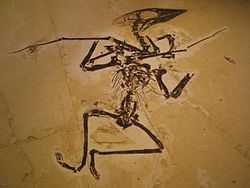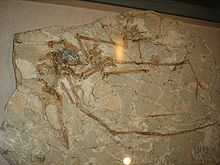Sinopterus
| Sinopterus Temporal range: Early Cretaceous, 120Ma | |
|---|---|
 | |
| S. dongi fossil | |
| Scientific classification | |
| Kingdom: | Animalia |
| Phylum: | Chordata |
| Order: | †Pterosauria |
| Clade: | †Azhdarchoidea |
| Family: | †Tapejaridae |
| Subfamily: | †Tapejarinae |
| Genus: | †Sinopterus Wang & Zhou, 2003 |
| Species | |
| |
| Synonyms | |
| |
Sinopterus (meaning "Chinese wing") was a genus of tapejarid pterodactyloid pterosaur from the Aptian-age Lower Cretaceous Jiufotang Formation of Chaoyang, Liaoning, China. Three species have been classified in this genus, though only two are generally considered to be valid. Sinopterus is known for its proportionally large skull, which has a birdlike pointed beak, a long bony crest that starts with a tall premaxilla and goes back along the middle of the skull to form a point overhanging the rear of the skull, and its lack of teeth.
Description and classification

The type species, S. dongi, is based on IVPP V13363, an articulated, nearly complete skeleton. The skull of this individual was 17 centimeters (6.7 inches) long, and the wingspan was estimated to be 1.2 meters (3.9 feet). The authors suggested that it was an omnivore, and noted that it was the first record of a tapejarid outside of Brazil, and the earliest and most complete tapejarid.[1]
A second species, S. gui, was named by Li, Lü, and Zhang in 2003 based on BPV-077, another nearly complete skeleton from the Jiufotang Formation. It was said to differ from S. dongi mainly in its smaller size (only about half the size of S. dongi) and the presence of a notarium,[2] though this was later disproved.[3] Most later studies have found S. gui to simply represent a younger specimen of S. dongi.[4]
A third species was referred to Sinopterus in 2007, S. jii. This species was first named by Lü & Yuan in 2005 as the type species of a new genus, which they named Huaxiapterus. However, two later studies in 2007 and 2011 both showed that H. jii was in fact more closely related to sinopterus than to two other species also assigned to Huaxiapterus, "H." corollatus and "H." benxiensis. Both groups of researchers concluded that Huaxiapterus jii should therefore be reclassified as Sinopterus jii, and that the other two species of "Huaxiapterus" require a new genus name.[3][4]
References
- ↑ Wang, X., and Zhou, Z. (2003). A new pterosaur (Pterodactyloidea, Tapejaridae) from the Early Cretaceous Jiufotang Formation of western Liaoning, China and its implications for biostratigraphy. Chinese Science Bulletin 48:16-23.
- ↑ Li, J., Lü, J., and Zhang, B. (2003). A new Lower Cretaceous sinopterid pterosaur from the Western Liaoning, China. Acta Palaeontologica Sinica 42(3):442-447.
- ↑ 3.0 3.1 Kellner, A.W.A. and Campos D.A. (2007). "Short note on the ingroup relationships of the Tapejaridae (Pterosauria, Pterodactyloidea)." Boletim do Museu Nacional, 75: 1-14.
- ↑ 4.0 4.1 Pinheiro, F.L., Fortier, D.C., Schultz, C.L., De Andrade, J.A.F.G. and Bantim, R.A.M. (in press). "New information on Tupandactylus imperator, with comments on the relationships of Tapejaridae (Pterosauria)." Acta Palaeontologica Polonica, in press, available online 03 Jan 2011. doi:10.4202/app.2010.0057
External links
- Sinopterus in The Pterosauria